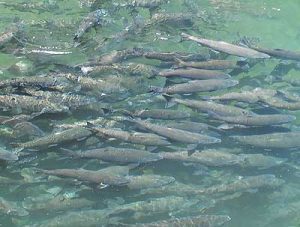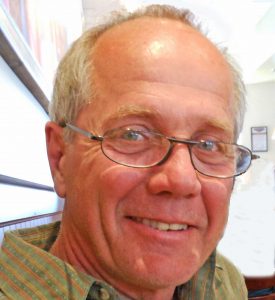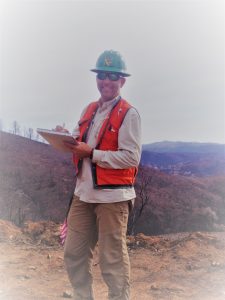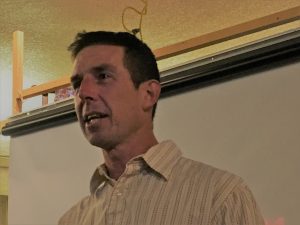by Dave Waddell
Beyond the staggering human losses in last month’s devastating Camp Fire, another potential loser from the inferno’s toxic runoff are Butte Creek’s highly valued Chinook salmon during a particularly vulnerable time in their lifecycle.

Whether and to what extent that spring-run salmon population is poisoned by a potential witches’ brew of toxins flowing from the extremely hot wildfire won’t truly be known for about three years. That’s when most of the surviving salmon that today are juveniles are due to return from the Pacific Ocean to spawn and die in Butte Creek.
The Camp Fire, which started Nov. 8, quickly became a mega-blaze that sprinted and sprawled through and beyond the Butte County communities of Paradise, Magalia and Concow. At least 86 people were killed and nearly 27,000 displaced in what became the deadliest wildfire in California history. The fire stormed through more than 150,000 acres and destroyed nearly 14,000 homes and in excess of 500 commercial structures.
While the Camp Fire was horrific for the humans and animals trapped inside it, biologists say the blaze will benefit wildlife long-term. In the near term, though, some species will struggle. Even birds, which were able to flee the flames, will have their own short-term winners and losers: Raptors in grasslands are better able to spot prey whose ground cover was turned to ash, while other birds will starve from a lack of acorns and berries during the winter.
But just as green grasses began peeking through Paradise’s ashen hillsides within weeks, wildlife for the most part will rebound and flourish because fire in their habitats is central to their well-being, biologists say. Fire returns nutrients to the soil and opens up the forest to sunshine to grow plants that feed wildlife.
In the aftermath of the fire, prescribed burning as it was conducted by native peoples to prevent future such firestorms is gaining increased public attention in Butte County.
Salmon creek robust
Spring-run Chinook salmon are named for the season that most begin returning as adults from the ocean to their fresh-water origins. Historically, the spring-run species were abundant throughout the state’s Central Valley — from the now-parched San Joaquin River in the south to the state’s northern-most waterways. However, a deep decline in the species led to its listing as endangered by the state and federal governments in 1999. Today, with spring-run salmon creeks having dwindled to a mere handful, Butte Creek is by far the Central Valley’s most robust and is considered key to the species’ health.
Last year, 2,100 adult salmon were counted in Butte Creek, compared with an average of about 500 per year each in Mill and Deer creeks.
“And that was a bad year for Butte Creek,” said fisheries expert Allen Harthorn. “Next year will be a substantial run of adults.”

Home to the salmon of Butte Creek is a 6-to-8 mile stretch from Helltown to just below the site of the historic Honey Run Covered Bridge, which perished in the Camp Fire.
Harthorn is a Helltown resident whose home survived the fire’s uncommon dash into Butte Creek Canyon, which connects the town of Paradise with the city of Chico. A lifetime angler, farmer and former agriculture and geography instructor at Chico State, Harthorn has been involved in Butte Creek fishery issues since 1995.
Harthorn told ChicoSol that because Butte Creek “is no stranger to fire,” its wildlife have “pretty well adapted” from after the Camp Fire.
“I’ve seen a lot of deer, quite a few turkeys and I noticed this morning that a bear got into our trash, so I know they’re still around,” Harthorn said in a recent interview.
Though a secondary concern to toxins, excess sediment caused by erosion from denuded hillsides also could harm the salmon’s habitat.
“The sheriff posted a video (of runoff) showing rocks moving right along with the soil,” Harthorn said. “That’s what we don’t want to see.”
Harthorn said the Camp Fire “behaved very differently” compared to previous blazes.
“So much of the fire was wind-driven,” Harthorn said. “It was the first time we had a fire come from Paradise to Butte Creek; it’s almost always the other way. … There were places where the fire burned very intensely – more intensely than I’ve ever seen.”
The timing of the Camp Fire couldn’t have been worse for the salmon, Harthorn said.
“The juveniles … are up out of the gravel and swimming around on their own,” he said. “They’re at their most vulnerable stage to toxic and excess sediment pollution.”
The fire’s unusually intense heat causes concern about what toxins have already melted into Butte Creek and what is still to come from winter runoff.
“I wouldn’t venture to guess what you’re going to find in a burned-out home,” Harthorn said. “Pesticides, paint, paint thinners, plastics. … Computers have heavy metals, and most everyone had a computer. … There was asbestos in a lot of the old buildings. … Just a whole suite of potentially harmful chemicals.”
‘Highly fire-dependent’ landscape
State wildlife officials say the intense and rapid advancement of the Camp Fire killed many animals, both domestic and wild, though some miraculous survivals were reported.
“Paradise contained numerous green belts that were home to a wide range of urban wildlife species … surrounded by … neighborhoods that burned and these animals had nowhere to flee,” according to Henry Lomeli, a state Department of Fish and Wildlife biologist. “Urban populations of … deer, bears, skunks, squirrels, foxes, rabbits, raccoons and other smaller animals that were fortunate enough to survive the initial wall of fire will most likely face higher winter mortality.”

Lomeli pointed out that the Camp Fire occurred in “predominantly chaparral and mixed conifer ecosystems” that contain a wide variety of wildlife and are “highly fire-dependent.” As a result, both the mammal and bird populations will benefit from the fire long-term, he said.
Asked by ChicoSol whether there would be any lingering negative effects on fish or wildlife, Lomeli replied: “A majority of the natural landscape that burned in the Camp Fire … could not be healthy without burning. … If you truly believe in functional ecosystems, then the long-term impact on wildlife due to the fire is positive.”
Prescribed burning pushed
Don Hankins, a Chico State geography professor, had been scheduled to speak Nov. 8 on the benefits of fire, but the talk was abruptly postponed as masses of ridge residents were desperately fleeing the firestorm that day. Hankins also had to evacuate his Forest Ranch home, which the fire spared.

When Hankins was able give his talk on Dec. 6, it was to a standing-room-only crowd at the Chico Creek Nature Center, with some late arrivals turned away because of the crowding.
“Most native animals have adapted to fire,” Hankins told the crowd. “A lot of species benefit from fire. … It’s not always doom and gloom.”
In Australia, indigenous peoples have long reported raptors dropping burning sticks from their beaks or talons to spread wildfire , he said.
Hankins also reported searching for a cat in the backyard of a home leveled in the Camp Fire and happening upon three massive bucks that were “bedded down.” He reported seeing other patches of deer, while birds also “were present” in the burned setting.
Hankins, whose academic expertise includes pyro geography and land restoration, is a passionate advocate for prescribed and controlled burning, drawing knowledge and inspiration from the practices of indigenous tribes, including the Mechoopda. He peppered his talk with comments such as “Burning should be a family affair” and “Everyone should be out setting fires.”
Hankins recalled being interviewed for his Chico State job in 2005 and being asked if he would burn in Bidwell Park, a 3,670-acre Chico treasure that’s the third-largest municipal park in California. “I said, ‘Yes!” Hankins said. “I think about fire everywhere I go.”
Hankins said the prescribed burning he oversees in the university-managed Butte Creek Ecological Preserve is motivated by a desire to protect the creek’s Chinook salmon: “If we’re not going to manage the habitat around them, they’ll be lost.”
Dave Waddell is news director at ChicoSol. This report was produced with support from Ethnic Media Services.

Dave, I’m really glad to see you head first into the important news of your area! Tom was a great roll model! I remember him always saying “ people that live in small towns deserve good journalism too!” Amen! Keep up the good work! Sadly we lost Earl Wright about a month ago! Your friend in news, Don!